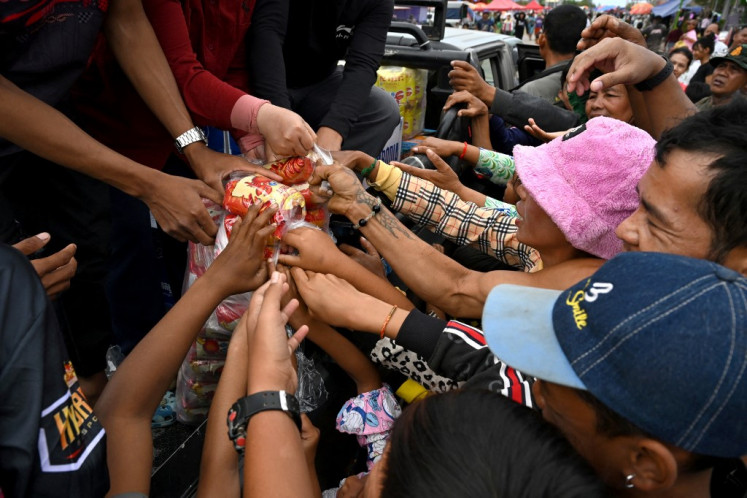Popular Reads
Top Results
Can't find what you're looking for?
View all search resultsPopular Reads
Top Results
Can't find what you're looking for?
View all search resultsCan BPJS Kesehatan survive after drastic premium hikes?
Worth the wait: Customers line up at an office of the Healthcare and Social Security Agency (BPJS Kesehatan) in Matraman, East Jakarta
Change text size
Gift Premium Articles
to Anyone
W
orth the wait: Customers line up at an office of the Healthcare and Social Security Agency (BPJS Kesehatan) in Matraman, East Jakarta. Following a hike in national health insurance (JKN) premiums in January, many customers have opted to downgrade their health insurance service class. (JP/Dhoni Setiawan)
The new year marks a new phase for Indonesia’s universal healthcare program, the National Health Insurance (JKN), as the government is set to double its premiums for the first time since it started operations in 2014.
The government is expecting the hikes to help cover the ballooning deficit recorded by the Healthcare and Social Security Agency (BPJS Kesehatan), which manages the JKN. It recorded a deficit of Rp 9.1 trillion (US$654.68 million) in 2018 alone, with an estimated accumulated deficit of Rp 32.84 trillion by 2019.
President Joko “Jokowi” Widodo eventually signed in a new Presidential Regulation (Perpres) in October to increase the monthly premiums for all three types of JKN services: first-class service from Rp 80,000 to Rp 160,000 per person, second class from Rp 51,000 to Rp 110,000 and third-class from Rp 25,500 to Rp 42,000. The new premiums, which start taking effect in January, got mixed reactions from the public.
Focusing on preventive efforts
Amid reports of the BPJS Kesehatan deficit, the government has paid much attention to evaluating hospitals, as 85 percent of the agency’s healthcare service spending went to hospitals as of August 2019. Last year, the spending on hospitals accounted for 84 percent of all healthcare service spending.
Health Minister Terawan Agus Putranto has repeatedly implied to the press that there had been instances where services provided by doctors were not based on suitable diagnoses, mentioning as an example the big costs BPJS had to spend on treatments for heart disease and cesarean section surgeries. He said services under the JKN scheme should be limited and cover only fundamental services, otherwise it could “collapse”.
“Health agencies should communicate with Puskesmas [community health centers] in enforcing preventive and promotive efforts. If fewer people fall sick, then fewer people will need healthcare services and [BPJS Kesehatan] won’t collapse. That’s why promotive and preventive efforts must be carried out,” he told the press after a meeting with all regional health agencies across the country in Jakarta in November 2019.
BPJS Kesehatan has attributed the high cost of healthcare services to the increasing number of chronic illness patients in the country, highlighting that health development at the source had not been optimal.
A 2016 World Bank report noted that Indonesia was undergoing a rapid epidemiological transition with noncommunicable diseases (NCDs) now accounting for the largest share of the country’s burden of disease. Whereas in 1990 only about 37 percent of morbidity and mortality in Indonesia was due to NCDs, by 2015 this number had risen to 66 percent and the trend was expected to continue in the years to come, the report said.
As of August, the BPJS Kesehatan’s 2019 spending for catastrophic illnesses was Rp 15.4 trillion, accounting for 21.6 percent of all healthcare service spending of Rp 71.2 trillion. In 2018, catastrophic illness spending accounted for 21.66 percent of all healthcare service spending: Rp 20.4 trillion out of Rp 94.2 trillion.
Timboel Siregar from BPJS Watch said that aside from preventing hospital fraud to control spending, preventive and promotive efforts should be enhanced among community health centers. In this case, community health centers should be empowered and that responsibility fell to the local administrations, he said.
Timboel argued that improving community health centers was important to decrease referrals to hospitals, which in turn would decrease spending. Under the JKN scheme, community health centers and private clinics partnering with the agency must be able to tend to 144 types of illnesses and only in some cases would referral to hospitals be required.
BPJS Kesehatan has disbursed monthly funds, called kapitasi, to these health centers and partnering clinics based on registered participants there without taking into account the types and the amount of healthcare services provided. BPJS Kesehatan recorded that in 2019, as of November, the referral rate to hospitals from community health centers and private clinics was 16.08 percent.
“The rate should be under 10 percent. The BPKP [Development Finance Comptroller] reported that there are kapitasi funds that haven’t been used to improve the community health centers. Improving them can be done by procuring medical facilities and equipment and upskilling medical workers,” Timboel said.
United Indonesian Doctors Association (PDIB) chairman James Allan Rarung said that community health centers had often used insufficient facilities, medicines and human resources as reasons to refer patients to hospitals. Patients had also preferred to go to hospitals as medicines and medical equipment there were deemed better than those at health centers, he said.
“In terms of promotive and preventive efforts, medical workers must provide services from door to door and to the community directly, instead of waiting for the people to come to the health centers,” he said.

Downgrading class
Observers have noted the possibility of independent JKN participants downgrading their health services given the big discrepancy in premiums between each class and also the possibility of the participants opting to be nonactive by no longer paying premiums after the hikes.
Independent participants are those who pay the premiums by themselves, as compared to employees, whose premiums are partly paid by their employers. As of November, there were 35 million independent participants, accounting for 16 percent of all 222 million JKN holders.
These are expected to affect the agency’s income, which mainly comes from premiums. From November to December 2019, the agency recorded that 3.53 percent of first-class participants, 153,466 people, had downgraded to lower classes, while 3.32 percent, 219,458, of second-class participants had decided to move to the third class.
The agency has in fact anticipated this by making it easier for participants to move to a lower class through a program called PRAKTIS, an abbreviation of “downgrading class is not difficult”. The program allows nonactive participants and those in arrears of premiums to downgrade easily.
Aside from the low premiums that were not based on actuary calculations, the government has largely attributed the BPJS’ deficit to independent participants who are not paying their premiums. This includes those who only register at times of illness and stop paying their premiums afterwards.
According to the Finance Ministry, in 2018 46.3 percent of independent participants did not pay their premiums — with arrears recorded between 2016 and 2018 amounting to Rp 15 trillion.
“There is indeed a lot to be done, including increasing the collectability of the premiums and improving the participants’ discipline in paying their premiums,” Timboel said.
The Health Ministry and the House of Representatives are currently discussing several scenarios to subsidize third-class participants so as to not burden them with the hikes.
Much of the focus has also been directed toward hospitals as doubts hover about their readiness to provide facilities, such as hospital wards, for the third-class participants should there be a surge in downgraders.
One of the reasons is because the third class also covers contribution assistance recipients (PBI), which consist of a large number of low income people whose premiums are paid using state and regional budgets. There are 96 million PBI participants assisted by the central government and 38 million by local administrations.
Indonesian Hospital Association (PERSI) chairman Kuntjoro Adi Purjanto said hospitals were anticipating the possibility of downgraders by increasing the number of their lower class wards.
“Until now, when third-class [wards] were full, patients were put in second-class [wards] instead of being dismissed because hospitals made serving patients a priority. Either that or patients had to wait for vacant wards in the emergency room [ER]. So if they’re waiting at the ER, it’s for no other reason than that they’re queuing for the wards,” Kuntjoro said, referring to claims that hospitals had been discriminatory toward JKN holders.
Such claims had been put forth by observers, including the Indonesian Consumers Foundation (YLKI) and Indonesian Corruption Watch. With the premium hikes, the YLKI, lawmakers and factions of the public have said they were expecting improvements in services.
Kuntjoro said that hospitals had been doing their best regardless of the premiums, expressing hope that the hikes could soon cover hospitals’ claims that had not been paid on time by BPJS Kesehatan, which had in turn disrupted hospitals’ cash flows. As of October 2019, the agency had yet to pay Rp 21 trillion in arrears of hospitals’ claims.
“PERSI has advised hospitals not to rely on JKN patients, but rather to innovate and attract non-JKN patients and private insurance companies. They may be difficult as JKN patients may account for more than 80 percent of total patients at some hospitals, but they are important for hospitals [to ensure a smooth cash flow],” he said.
Ensuring sustainability
BPJS Kesehatan has failed to meet its target of increasing its participants to 95 percent of the population despite Law No. 40/2004 on national social security reform having stipulated that all citizens must be participants of the JKN program. The agency said it would continue to distribute information and education to raise participation while also improving service quality to attract more citizens.
Timboel of BPJS Watch said that increasing participation to 95 percent of the population was important to increase BPJS Kesehatan’s premiums income, which would allow it to better implement its gotong royong (mutual cooperation) principle in which the healthy help the ill and the rich help the poor.
“The working period of the current board of directors and supervisory board will end in 2021. The selection committee will be formed in 2020 and the committee will have to be able to find directors and supervisors who are creative, innovative, proactive and actively reach out to attract participants rather than just waiting for them to register themselves,” he said.
He added that premiums must be reviewed every two years, as regulated, and that any increase in the premiums should be based on actuarial calculations. Timboel, however, did not sound optimistic as the coming review would be scheduled near the political year of 2023 and 2024, meaning that policy makers would possibly refrain from implementing any unpopular policies among their constituents, just like in 2018.










